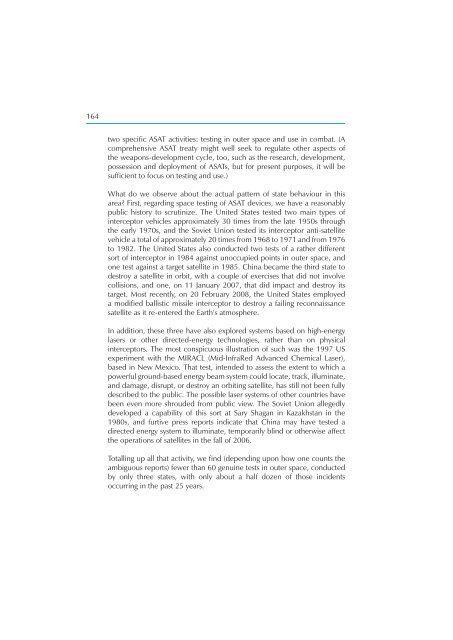Security in Space The Next Generation - UNIDIR
Security in Space The Next Generation - UNIDIR
Security in Space The Next Generation - UNIDIR
Create successful ePaper yourself
Turn your PDF publications into a flip-book with our unique Google optimized e-Paper software.
164<br />
two specifi c ASAT activities: test<strong>in</strong>g <strong>in</strong> outer space and use <strong>in</strong> combat. (A<br />
comprehensive ASAT treaty might well seek to regulate other aspects of<br />
the weapons-development cycle, too, such as the research, development,<br />
possession and deployment of ASATs, but for present purposes, it will be<br />
suffi cient to focus on test<strong>in</strong>g and use.)<br />
What do we observe about the actual pattern of state behaviour <strong>in</strong> this<br />
area? First, regard<strong>in</strong>g space test<strong>in</strong>g of ASAT devices, we have a reasonably<br />
public history to scrut<strong>in</strong>ize. <strong>The</strong> United States tested two ma<strong>in</strong> types of<br />
<strong>in</strong>terceptor vehicles approximately 30 times from the late 1950s through<br />
the early 1970s, and the Soviet Union tested its <strong>in</strong>terceptor anti-satellite<br />
vehicle a total of approximately 20 times from 1968 to 1971 and from 1976<br />
to 1982. <strong>The</strong> United States also conducted two tests of a rather different<br />
sort of <strong>in</strong>terceptor <strong>in</strong> 1984 aga<strong>in</strong>st unoccupied po<strong>in</strong>ts <strong>in</strong> outer space, and<br />
one test aga<strong>in</strong>st a target satellite <strong>in</strong> 1985. Ch<strong>in</strong>a became the third state to<br />
destroy a satellite <strong>in</strong> orbit, with a couple of exercises that did not <strong>in</strong>volve<br />
collisions, and one, on 11 January 2007, that did impact and destroy its<br />
target. Most recently, on 20 February 2008, the United States employed<br />
a modifi ed ballistic missile <strong>in</strong>terceptor to destroy a fail<strong>in</strong>g reconnaissance<br />
satellite as it re-entered the Earth’s atmosphere.<br />
In addition, these three have also explored systems based on high-energy<br />
lasers or other directed-energy technologies, rather than on physical<br />
<strong>in</strong>terceptors. <strong>The</strong> most conspicuous illustration of such was the 1997 US<br />
experiment with the MIRACL (Mid-InfraRed Advanced Chemical Laser),<br />
based <strong>in</strong> New Mexico. That test, <strong>in</strong>tended to assess the extent to which a<br />
powerful ground-based energy beam system could locate, track, illum<strong>in</strong>ate,<br />
and damage, disrupt, or destroy an orbit<strong>in</strong>g satellite, has still not been fully<br />
described to the public. <strong>The</strong> possible laser systems of other countries have<br />
been even more shrouded from public view. <strong>The</strong> Soviet Union allegedly<br />
developed a capability of this sort at Sary Shagan <strong>in</strong> Kazakhstan <strong>in</strong> the<br />
1980s, and furtive press reports <strong>in</strong>dicate that Ch<strong>in</strong>a may have tested a<br />
directed energy system to illum<strong>in</strong>ate, temporarily bl<strong>in</strong>d or otherwise affect<br />
the operations of satellites <strong>in</strong> the fall of 2006.<br />
Totall<strong>in</strong>g up all that activity, we fi nd (depend<strong>in</strong>g upon how one counts the<br />
ambiguous reports) fewer than 60 genu<strong>in</strong>e tests <strong>in</strong> outer space, conducted<br />
by only three states, with only about a half dozen of those <strong>in</strong>cidents<br />
occurr<strong>in</strong>g <strong>in</strong> the past 25 years.








